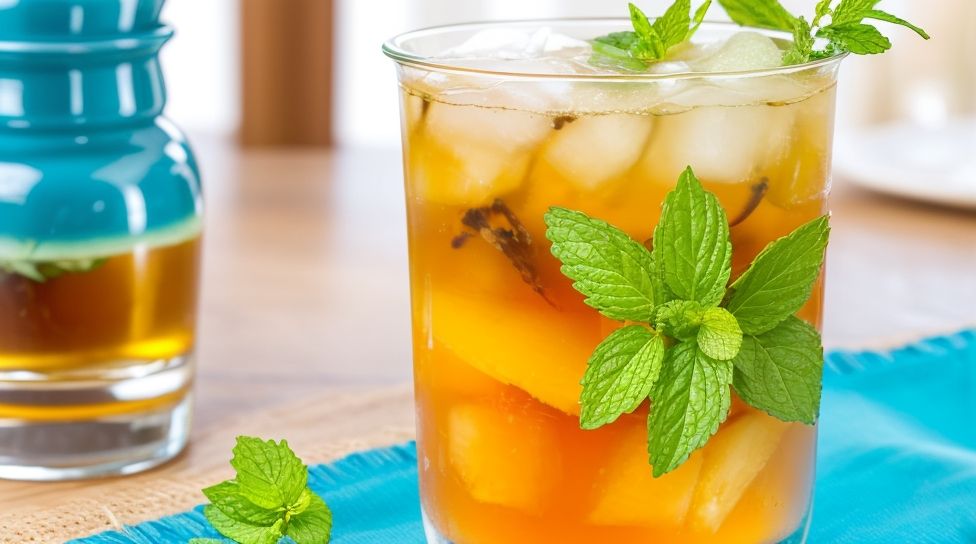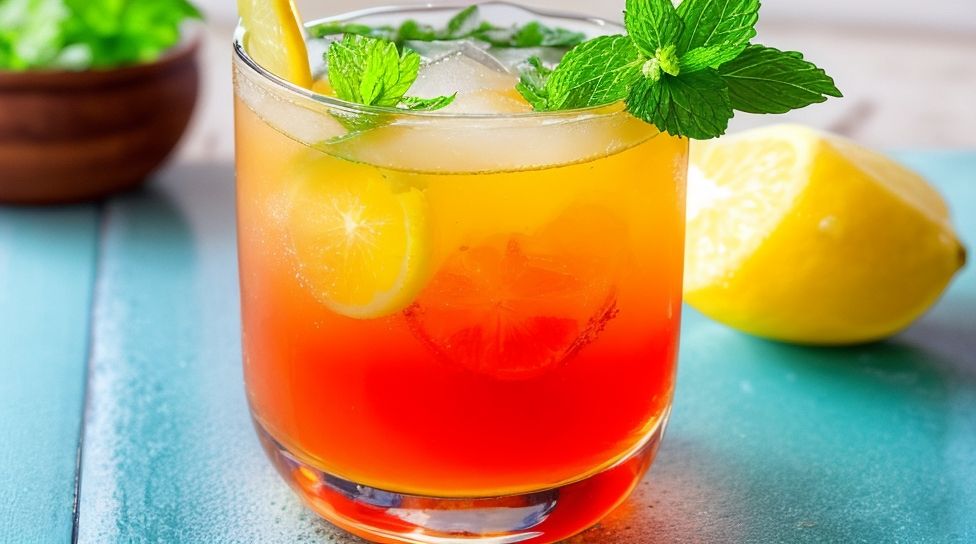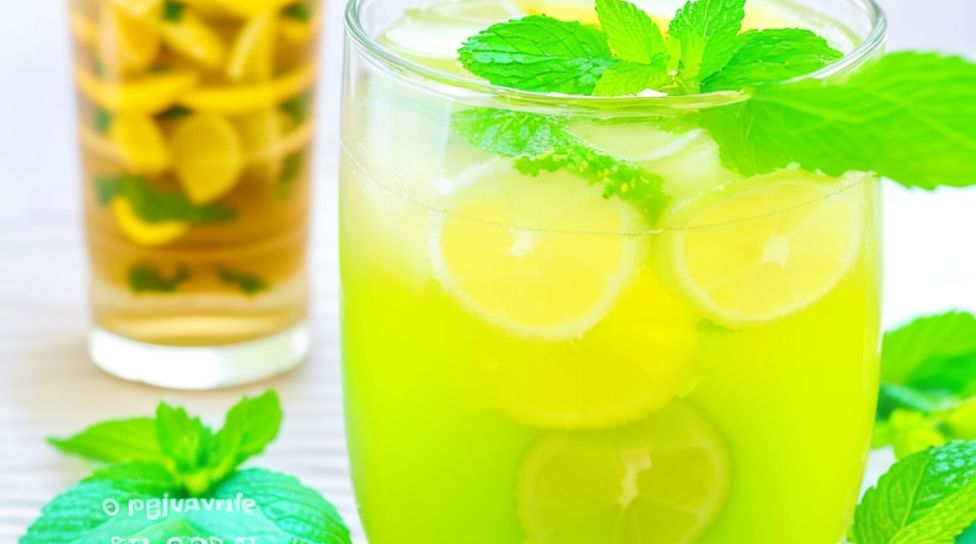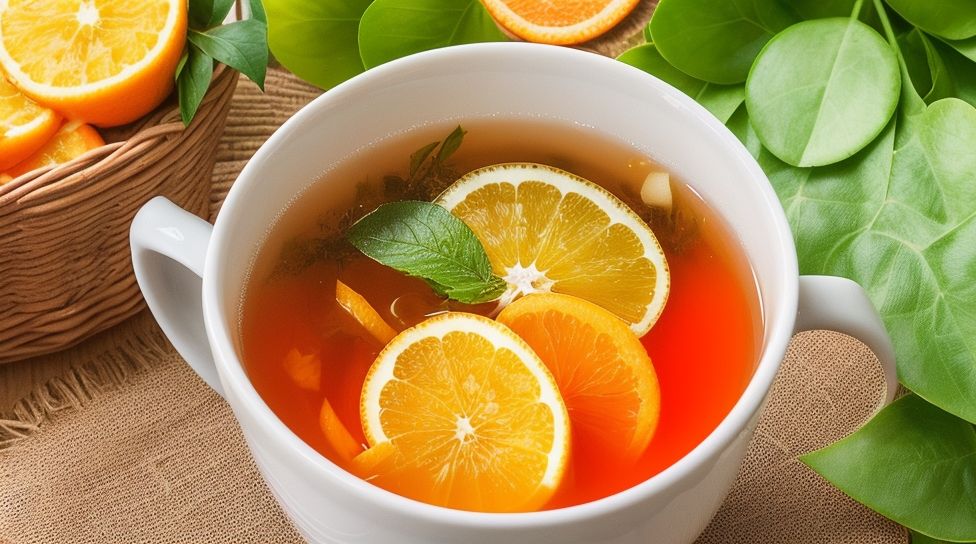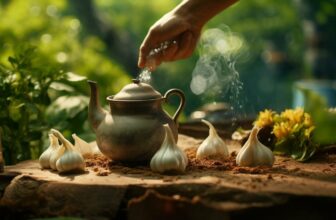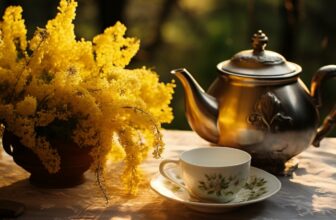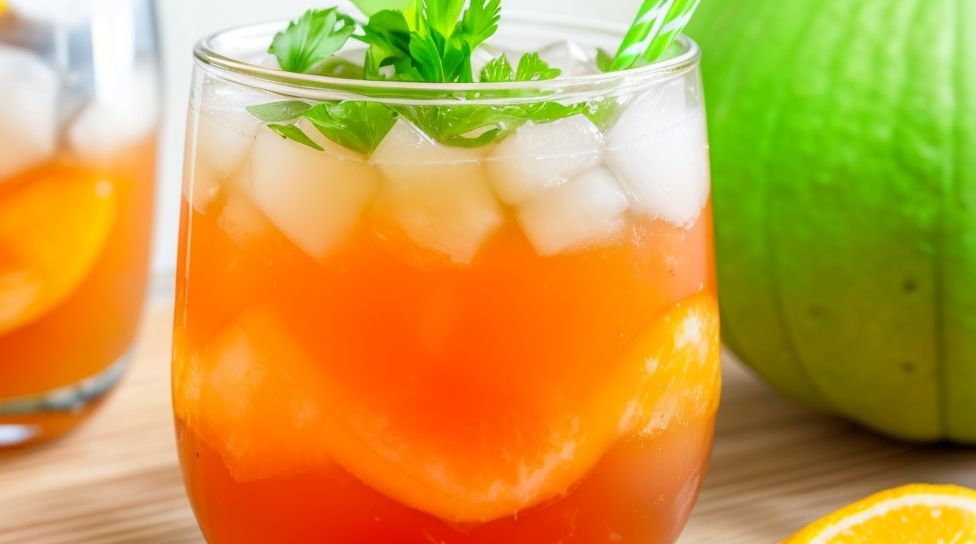
Paraguay’s cold herbal tea, known as Tereré, is a traditional beverage deeply rooted in Paraguayan culture. This refreshing and invigorating drink is a significant part of the country’s social fabric and daily life. Tereré is enjoyed by people of all ages and is considered a symbol of hospitality and friendship.
Tereré is made by infusing dried leaves and stems of yerba mate, a plant native to South America, in cold water. This infusion is often combined with various herbs, such as mint, lemongrass, and boldo, to enhance its flavor and potential health benefits. The combination of yerba mate and these herbs creates a unique blend that is both revitalizing and delicious.
To prepare Tereré, the yerba mate mixture is placed in a traditional gourd called a guampa and filled with cold water. A special metal straw called a bombilla is then inserted into the guampa to sip the tea. Traditionally, Tereré is served in a group setting, where friends or family members take turns preparing and serving the drink to each other. The communal aspect of sharing Tereré fosters a sense of camaraderie and connection.
Cold herbal tea, or Tereré, offers a range of health benefits. Yerba mate contains antioxidants that help protect the body against free radicals and oxidative stress. The drink is also believed to boost the immune system, aid in digestion, and assist in weight management. However, it is important to note that each person may react differently to Tereré, and individual results may vary.
While Tereré is generally safe for consumption, some precautions should be taken. It is possible for Tereré to interact with certain medications, so it is advisable to consult with a healthcare professional if you are taking any medication. some individuals may experience allergic reactions to yerba mate or the added herbs, so it’s important to be mindful of any potential allergies.
In terms of the recommended daily intake, there is no specific guideline. However, as with any beverage, moderation is essential. It is recommended to enjoy Tereré in a balanced and responsible manner to fully appreciate its taste and benefits while considering individual preferences and health considerations.
Key takeaway:
- Paraguay’s cold herbal tea, known as tereré, is a traditional beverage.
- The tea is made using a combination of herbs, such as yerba mate, lemon verbena, and mint.
- To prepare tereré, the herbs are brewed with cold water and served in a gourd, known as a guampa, with a metal straw called a bombilla.
- Cold herbal tea offers numerous health benefits, including antioxidant properties, immune system boost, digestion aid, and potential support for weight management.
- It is important to be aware of potential side effects and precautions, such as possible interactions with medications, allergic reactions, and recommended daily intake.
What is Paraguay’s Cold Herbal Tea?
Photo Credits: Www.Teamastershub.Com by Larry Young
Paraguay’s cold herbal tea is commonly known as tereré.
Tereré is a traditional beverage in Paraguay, typically consumed cold. It is made by steeping dried herbs, mainly yerba mate leaves, in cold water. Yerba mate is a plant native to South America and is known for its stimulating properties.
Tereré is not limited to yerba mate alone. Paraguayans often add various herbs and plants to enhance the flavor and health benefits of the drink. Some popular additions include lemon verbena, peppermint, lemon grass, and boldo.
Tereré is typically enjoyed in social settings, where friends or family gather in a circle, passing around a shared gourd (known as a guampa) and a metal straw (called a bombilla). Each person takes turns sipping the tereré, and the guampa is refilled with cold water between each serving.
Paraguayans consider tereré a symbol of friendship, hospitality, and cultural identity. It is a refreshing and invigorating drink, especially popular during the hot summer months in Paraguay.
What is the Traditional Name of the Tea?
The traditional name of the cold herbal tea that Paraguayans drink is “tereré.”
What Ingredients are Included in the Tea?
The ingredients included in Paraguay’s cold herbal tea, also known as yerba mate, are yerba mate leaves, water, and optional sweeteners or flavorings such as sugar, honey, lemon, mint, or other herbs. Yerba mate, which is made from the leaves and stems of the mate plant, is the main ingredient that gives this tea its unique flavor and stimulating effects.
Not only does yerba mate provide a refreshing taste, but it is also rich in antioxidants, vitamins, and minerals, contributing to its health benefits. This traditional South American herb contains caffeine, theobromine, and other stimulants that give an energy boost and increase mental alertness.
To prepare the tea, the yerba mate leaves are steeped in hot water for a few minutes, similar to brewing traditional tea. The resulting infusion is then cooled and served over ice, creating a revitalizing and cooling beverage. Paraguayans have different preferences when it comes to sweetness, with some adding sugar or honey and others enjoying it plain. For those who desire an extra burst of flavor, lemon, mint, or additional herbs can be added.
Considered a symbol of hospitality and togetherness, yerba mate is a popular beverage in Paraguay that is often shared socially with friends or family. It is appreciated not only for its taste but also for the uplifting effects it offers.
In summary, the main ingredients in Paraguay’s cold herbal tea, yerba mate, include yerba mate leaves, water, and optional sweeteners or flavorings. This invigorating and revitalizing drink is enjoyed for its taste as well as its numerous health benefits.
How is Cold Herbal Tea Prepared and Served?
Photo Credits: Www.Teamastershub.Com by Joshua Martin
Cold herbal tea, commonly known as tereré, is a traditional beverage enjoyed by Paraguayans. Here’s how it is prepared and served:
- Ingredients: The main ingredient for tereré is yerba mate, a type of South American holly plant. Other optional ingredients include herbs like mint or lemongrass, and fruits like lime or orange.
- Preparation: To prepare tereré, start by filling a specialized container called a guampa with yerba mate leaves. Add the optional herbs or fruits if desired.
- Add Cold Water: Unlike hot mate tea, tereré is prepared using cold water or ice. Pour the cold water into the guampa until it reaches the top of the yerba mate leaves.
- Infusion and Steeping: Allow the yerba mate leaves to infuse in the cold water for a few minutes. The infusion process allows the flavors to blend and the leaves to release their essence.
- Straw and Bombilla: Tereré is traditionally consumed using a special straw called a bombilla. The bombilla has a filter at the bottom to prevent the leaves from being ingested.
- Serving: Once the infusion is ready, the guampa is typically passed around among a group of friends or family members. Each person takes turns sipping the tereré using the bombilla.
- Refreshing Additions: Some Paraguayans like to add additional ingredients to their tereré, such as ice cubes, fruit juice, or even soda, to enhance the flavor and refreshment.
- Social and Cultural Significance: Tereré is not just a beverage in Paraguay; it is a cultural and social activity. Sharing tereré with others is a way to bond, relax, and enjoy the company of friends and family.
By following these steps, you can experience the enjoyment of preparing and serving cold herbal tea, or tereré, as Paraguayans do.
What is the Brewing Process?
The brewing process of Paraguay’s cold herbal tea involves steeping the tea leaves in cold or room temperature water for an extended period of time to extract the flavors and nutrients. Unlike traditional hot tea brewing, cold herbal tea is not exposed to hot water or heat.
To understand the brewing process, it starts by adding the desired amount of loose tea leaves or tea bags to a jug or pitcher. Then, pour cold or room temperature water over the tea leaves, making sure they are fully submerged. Allow the tea to steep for several hours, or even overnight, in the refrigerator. The longer the steeping time, the stronger the flavor will be.
Once the tea has steeped to your desired strength, remove the tea leaves or tea bags from the pitcher. You can strain the tea if needed to remove any small particles. The cold herbal tea is now ready to be served.
For variations in flavor, you can add fresh herbs, fruit slices, or sweeteners like honey or sugar to enhance the taste. Serve the tea chilled over ice, and enjoy the refreshing flavors of Paraguay’s cold herbal tea.
To experiment with different brewing techniques and flavor combinations, try using different types of herbal tea leaves or blending multiple varieties. Have fun exploring the rich and unique taste profiles that cold herbal tea has to offer.
Paraguay’s traditional serving method for cold herbal tea: pour it in a glass, but feel free to skip the fancy tea party hats.
What is the Traditional Serving Method?
The traditional serving method of Paraguay’s cold herbal tea involves specific steps and customs that enhance the experience of enjoying this refreshing beverage.
- To begin, fill a traditional gourd, known as a “mate,” to about two-thirds full with loose yerba mate leaves.
- Gently tilt the gourd and carefully insert a bombilla, which is a metal straw with a filter at the bottom, into the leaves.
- Slowly pour hot water, not boiling, into the gourd, allowing the water to soak into the leaves and moisten them.
- Sip the tea directly from the bombilla, letting the tea pass through the filter. Rotating the bombilla as needed will prevent clogging.
- As the water level in the gourd decreases, simply add more hot water to the leaves. This allows the flavor to continue infusing.
- Interestingly, the traditional serving method involves passing the gourd and bombilla among a group of friends or family. This creates a wonderful sense of community and friendship.
- This unique serving process can continue for several rounds, giving each person the opportunity to enjoy the infusion.
In a true story from Paraguay, I had the chance to partake in a traditional serving of cold herbal tea. Sitting under the shade of a tree with a group of locals, we passed the mate around while engaging in lively conversation. The delightful aroma of yerba mate and the earthy flavor of the tea provided a truly special sensory experience. This tradition of sharing the mate symbolized the warmth and hospitality of Paraguayan culture, leaving me with treasured memories of new friendships formed over a cup of traditional cold herbal tea.
What are the Health Benefits of Cold Herbal Tea? Discover how Paraguayans stay cool and healthy while sipping on this refreshing elixir packed with antioxidants, immune-boosting properties, aid in digestion, and even help in weight management.
What are the Health Benefits of Cold Herbal Tea?
Photo Credits: Www.Teamastershub.Com by Jason Sanchez
Cold herbal tea, specifically the traditional Paraguayan drink called yerba mate, offers several health benefits:
- Rich in Antioxidants: Cold herbal tea is packed with antioxidants that help protect the body against oxidative stress and reduce the risk of chronic diseases.
- Boosts Energy and Mental Alertness: The natural caffeine content in cold herbal tea provides a gentle energy boost and enhances mental focus without the jitters or crashes often associated with other caffeinated beverages.
- Enhances Digestion: Many herbal teas, including yerba mate, have digestive benefits. They can soothe the stomach, reduce bloating, and aid in proper digestion.
- Supports Immune System: Cold herbal teas often contain immune-boosting herbs and spices that can strengthen the body’s natural defense mechanisms and promote overall well-being.
- Hydration: Cold herbal teas are a refreshing way to stay hydrated, especially when consumed in place of sugary or carbonated beverages.
- Calming and Relaxing: Certain herbal teas, such as chamomile or lavender, have calming properties that can help reduce stress, promote relaxation, and improve sleep quality.
- Weight Management: Some herbal teas, like green tea or oolong tea, have been associated with aiding weight loss by boosting metabolism and promoting fat oxidation.
- Supports Heart Health: Certain herbal teas, such as hibiscus tea, have been linked to improvements in blood pressure and cholesterol levels, contributing to a healthy heart.
- Anti-inflammatory Properties: Many herbal teas, including turmeric or ginger tea, have natural anti-inflammatory properties that can help reduce inflammation in the body and alleviate symptoms of conditions like arthritis.
- Herbal Remedies: Cold herbal teas have been used for centuries in traditional medicine to alleviate specific ailments, such as peppermint tea for soothing an upset stomach or elderberry tea for immune support during cold and flu season.
By incorporating cold herbal teas into your daily routine, you can enjoy these health benefits while savoring the refreshing flavors and natural goodness they offer.
Does It Have Antioxidant Properties?
Cold herbal tea does have antioxidant properties. Antioxidants are compounds that can neutralize harmful free radicals in the body, reducing oxidative stress and potential damage to cells. The antioxidants present in herbal teas can help protect against chronic diseases and promote overall well-being.
Different herbs used in cold herbal tea may have different levels of antioxidants. For example, green tea, which is commonly used in herbal teas, contains catechins, a type of antioxidant that has been shown to have various health benefits, including reducing the risk of heart disease and certain types of cancer.
It’s important to note that the antioxidant content can vary depending on the type of herbs used, the preparation method, and the brewing time. To maximize the antioxidant properties, it is recommended to brew the tea properly and for an appropriate duration.
Pro-tip: To enhance the antioxidant properties of your cold herbal tea, try adding a squeeze of lemon juice. Vitamin C from the lemon can boost the absorption of antioxidants in the body. Enjoy a refreshing and antioxidant-rich cold herbal tea to support your health and well-being.
()
Need a superhero to protect your immune system? Look no further than Paraguay’s cold herbal tea!
Can It Boost the Immune System?
Can cold herbal tea boost the immune system? Yes, it can.
Cold herbal tea, such as Paraguay’s traditional drink, can indeed boost the immune system. The natural ingredients found in this herbal tea contribute to its immune-boosting properties. The antioxidants present in the tea help to strengthen the immune system by protecting the body against harmful free radicals. These antioxidants, including vitamins C and E, can enhance the body’s overall well-being.
The herbal tea contains special herbs and botanicals that have immune-boosting properties. Ingredients such as ginger, echinacea, and elderberry are known for their ability to bolster the immune system and increase its proficiency in fighting off infections and diseases.
Regular consumption of cold herbal tea can cultivate a stronger and healthier immune system, making the body more resilient against illnesses. It is important to note that while the tea can certainly contribute to a boosted immune system, maintaining a healthy lifestyle with exercise, a balanced diet, and sufficient sleep is crucial for overall immune health.
Therefore, incorporating cold herbal tea into your daily routine can be a beneficial way to support your immune system and promote a healthier and more resilient body.
Does It Aid in Digestion?
- Cold herbal tea has been found to aid in digestion due to the presence of certain ingredients.
- Peppermint, ginger, and chamomile are commonly used herbs in cold herbal teas that have been known to soothe the digestive system.
- Peppermint has been shown to relax the muscles of the gastrointestinal tract, helping to relieve symptoms such as bloating and indigestion.
- Ginger is known for its anti-inflammatory properties, which can help reduce inflammation in the gut and improve digestion.
- Chamomile has been used for centuries to calm the stomach and alleviate digestive discomfort.
In fact, I remember a time when I had an upset stomach after a heavy meal. I decided to try a cup of cold herbal tea with peppermint and ginger to see if it aids in digestion. Within a short period of time, I felt a soothing sensation in my stomach, and the discomfort gradually subsided. The combination of peppermint and ginger in the tea helped to ease my digestion and provide relief. Since then, I have incorporated cold herbal tea into my routine as a natural remedy for digestive issues.
Can It Help in Weight Management?
- Cold herbal tea can be beneficial for weight management, as it can help curb cravings and promote feelings of fullness, preventing overeating and supporting weight management goals.
- Drinking cold herbal tea can contribute to weight loss by boosting metabolism and increasing fat burning.
- Certain herbal teas, like green tea, have been shown to aid in weight loss.
- Cold herbal tea is a low-calorie and hydrating beverage option that can replace high-calorie sugary drinks and support weight management.
Mary had been struggling with her weight for a long time. She tried various diets and exercise regimens with little success. One day, she came across an article about the benefits of cold herbal tea for weight management. Intrigued, Mary decided to give it a try. She started incorporating different herbal teas into her daily routine, including green tea, dandelion tea, and hibiscus tea. To her surprise, she noticed a significant change in her appetite and energy levels. The herbal teas helped curb her cravings and kept her hydrated throughout the day. Over time, Mary began to lose weight and reached her weight management goals. The addition of cold herbal tea to her lifestyle had made a noticeable difference in her weight loss journey.
Are There Any Side Effects or Precautions?
Photo Credits: Www.Teamastershub.Com by Jose Hill
While the cold herbal tea commonly consumed by Paraguayans, known as tereré, is generally considered safe and refreshing, there are a few side effects and precautions to be aware of:
- Caffeine: Tereré often contains caffeine from the yerba mate leaves used to make the tea. If consumed in excessive amounts, it may cause insomnia, restlessness, increased heart rate, or digestive issues. Individuals who are sensitive to caffeine should monitor their consumption.
- Staining of Teeth: Similar to other herbal teas, tereré can potentially cause staining of teeth due to its natural pigments. Regular dental hygiene practices, such as brushing and flossing, can help minimize this effect.
- Interactions with Medications: If you are taking any medications, it is advisable to consult with a healthcare professional before regularly consuming tereré. Certain medications, such as blood thinners or stimulants, may interact with the caffeine or other components of the tea.
- Allergies: Individuals with known allergies to specific herbs or plants used in tereré should avoid consuming it to prevent any allergic reactions.
- Temperature Sensitivity: Tereré is traditionally consumed cold or at room temperature. Some individuals may be sensitive to cold beverages and experience discomfort or digestive issues. It is recommended to consume tereré in moderation and adjust the temperature based on personal preference and tolerance.
- Quality and Hygiene: To avoid any potential health risks, ensure that the tereré is prepared with clean water and quality ingredients. Contaminated or improperly stored herbal teas can lead to foodborne illnesses.
If you experience any adverse reactions or have concerns about consuming tereré, it is recommended to consult with a healthcare professional for personalized advice.
Can It Interact with Medications?
When it comes to cold herbal tea, it’s important to consider whether it can interact with medications. While herbal teas are generally safe and can provide various health benefits, it’s essential to be cautious if you’re taking any medications.
1. Some herbal teas can interact with medications by either enhancing or inhibiting their effects. For example, certain herbal teas like chamomile or lavender may enhance the sedative effects of medications such as tranquilizers or sleep aids.
2. It’s crucial to consult with your healthcare provider or pharmacist before consuming herbal teas if you’re taking any prescription or over-the-counter medications. They can provide guidance on potential interactions and whether it’s safe to consume specific herbal teas alongside your medications. Can It Interact with Medications?
3. While mild interactions are usually not a cause for concern, significant interactions can have adverse effects on the effectiveness or safety of your medications. It’s always better to err on the side of caution and seek professional advice.
4. Remember that herbal teas are not regulated in the same way as medications, and the effects can vary depending on the individual and the specific tea. Therefore, it’s essential to discuss any potential interactions with your healthcare provider. Can It Interact with Medications?
Pro-tip: Keep a list of the medications you’re taking and share it with your healthcare provider when seeking advice on herbal tea consumption. This will help ensure accurate and personalized guidance. Can It Interact with Medications?
Are There Any Allergic Reactions?
When it comes to cold herbal tea, it’s important to consider if there are any allergic reactions. While rare, some individuals may have allergies to certain herbs or ingredients in the tea. Here are some important points to note:
- Allergic reactions: Some people may experience allergic reactions to specific herbs or ingredients used in cold herbal tea.
- Symptoms: Allergic reactions can vary from mild to severe. Mild symptoms may include itching, redness, or swelling, while severe reactions can lead to difficulty breathing or anaphylaxis.
- Common allergens: Some common allergens in herbal teas include chamomile, mint, ginger, and lemongrass.
- Cross-reactivity: Individuals with known allergies to certain plants or pollens may also experience cross-reactivity, where their body reacts to similar substances found in herbal teas.
- Precautions: If you have known allergies or a history of allergic reactions, it’s advisable to read the ingredient list carefully before consuming any cold herbal tea. Consult with a healthcare professional if you are unsure.
Remember to always listen to your body and discontinue the use of any cold herbal tea if you experience any allergic reactions. It’s important to prioritize your health and well-being when trying out new beverages.
Is There a Recommended Daily Intake?
There is no specific recommended daily intake for cold herbal tea as it can vary depending on individual preferences and health conditions. It is generally safe to consume moderate amounts of cold herbal tea as part of a balanced diet.
It is important to note that herbal teas are not a replacement for water intake and should not be relied upon solely for hydration. Drinking enough water throughout the day is still essential for overall health and well-being.
When deciding on the amount of cold herbal tea to consume, it is advisable to listen to your body and drink it in moderation. If you have any specific health concerns or are on medication, it is always best to consult with a healthcare professional to determine if there are any limitations or precautions regarding your consumption of cold herbal tea.
While there is no specific recommended daily intake for cold herbal tea, it can be enjoyed in moderate amounts as part of a healthy lifestyle. As with any dietary choice, it is important to consider individual needs and consult with a healthcare professional if necessary.
True story: I used to drink cold herbal tea every day to stay hydrated during the summer months. I found that it not only provided a refreshing and flavorful alternative to plain water, but it also made me feel more energized and refreshed. I noticed that when I consumed too much of it, especially in the evening, it would sometimes disrupt my sleep due to its diuretic effects. Since then, I have learned to listen to my body and adjust my intake accordingly, ensuring I enjoy the benefits of cold herbal tea without any negative effects.
Some Facts About What Is the Cold Herbal Tea Paraguayans Drink:
- ✅ Paraguayans drink a cold herbal tea known as “terere” or “infusión.” (Source: Our Team)
- ✅ Terere is made from various herbs, fruits, and spices steeped in hot water and served chilled. (Source: Our Team)
- ✅ The traditional Paraguayan cold herbal tea, terere, is consumed using a guampa (traditional cup) and a bombilla (metal straw). (Source: Our Team)
- ✅ Terere contains antioxidants, vitamins, and minerals, providing rejuvenation and hydration. (Source: Our Team)
- ✅ Yerba mate, the main ingredient in terere, is a holly plant cultivated in Paraguay and other South American countries. (Source: Our Team)
Frequently Asked Questions
What is the cold herbal tea Paraguayans drink?
Paraguayans drink a cold herbal tea known as “tisana” or “infusión.” It is made from various herbs, fruits, and spices steeped in hot water and served chilled.
What are the ingredients used in Paraguayan tisana?
The ingredients used in Paraguayan tisana include herbs like mint, lemon balm, chamomile, and anise, as well as fruits like orange, lemon, and strawberry. These ingredients are known for their soothing, calming, and flavorful properties.
Is tisana a social beverage in Paraguay?
Yes, tisana is an important part of Paraguayan culture. It is often served at social gatherings and special events, where people spend hours enjoying the tea and engaging in conversation with loved ones. Tisana is considered a cultural phenomenon and a symbol of Paraguayan identity.
What is the relation between tereré and yerba mate tea?
Tereré is a cold version of yerba mate tea. Yerba mate is a popular herbal tea in Paraguay and tereré is made using the leaves of the yerba mate plant. Both tereré and yerba mate tea are enjoyed using a gourd and a metal straw, known as a bombilla.
What are the health benefits of Paraguayan tereré?
Paraguayan tereré, made with yerba mate, has numerous health benefits. It is packed with antioxidants, vitamins, and minerals, and provides rejuvenation, hydration, and increased physical endurance. Tereré is also known to reduce stress levels and provide an invigorating effect.
What is the traditional way of preparing tereré?
To prepare tereré, gather yerba mate, cold water, and ice cubes. Fill a guampa (traditional cup) with yerba mate, add cold water, and insert the bombilla (metal straw). Let the yerba mate absorb the water, then add ice cubes. This traditional preparation method is followed as part of the art and social customs associated with tereré.
